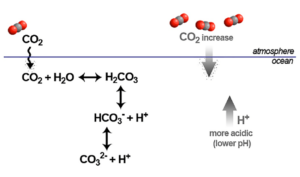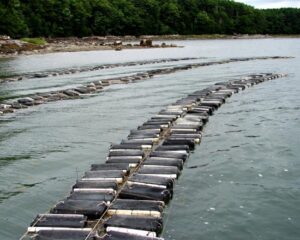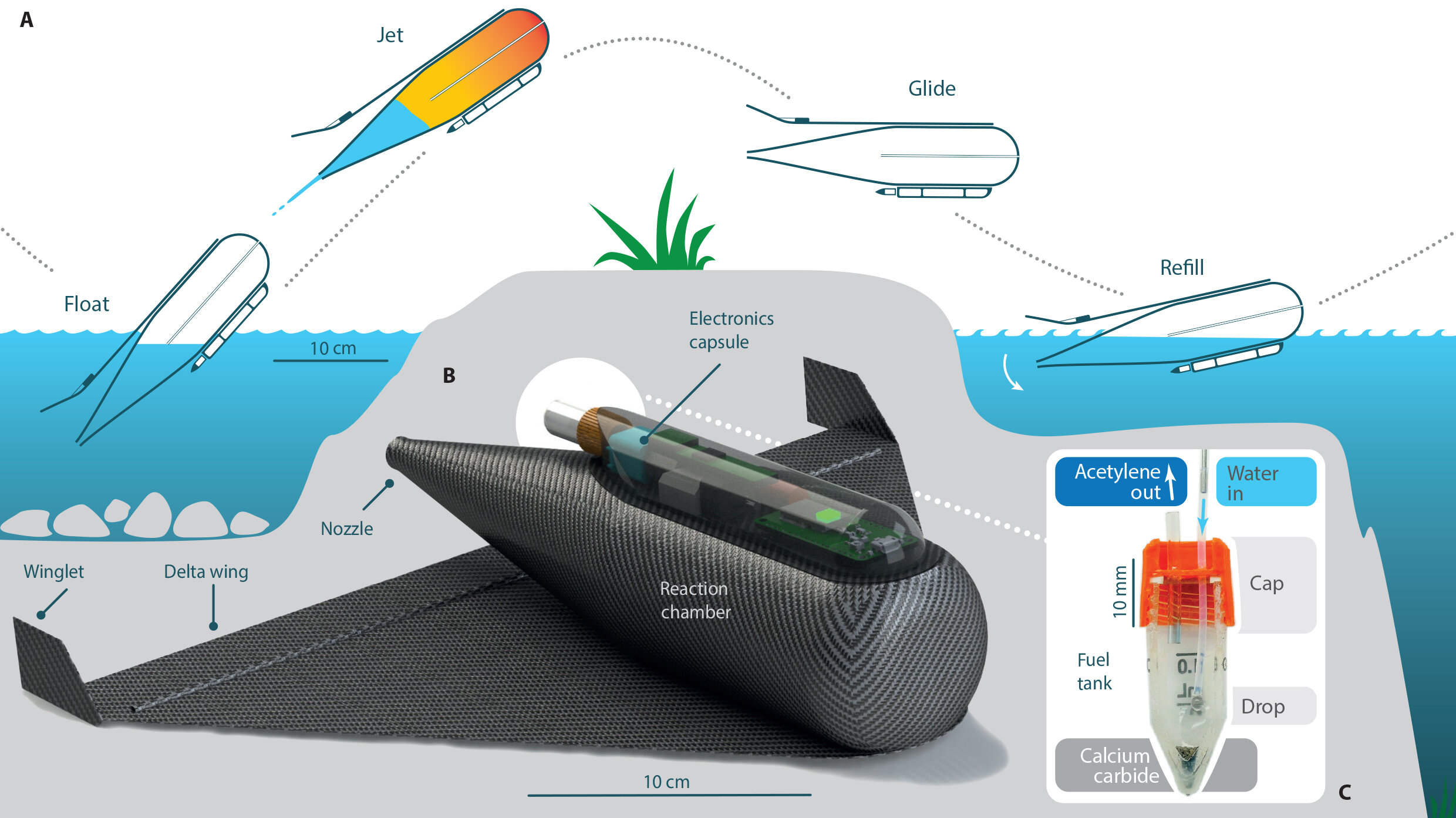Reference: Liberti, C. M., et al. (2022). “The impact of oyster aquaculture on the estuarine carbonate system.” Elementa: Science of the Anthropocene 10(1).
Link: https://online.ucpress.edu/elementa/article/10/1/00057/119261
Ocean acidification and oyster aquaculture
Ocean acidification has been worsening since the industrial revolution as more carbon dioxide (CO2) has been pumped into the atmosphere through the burning of fossil fuels for human industry. Some of the excess CO2 dissolves in the ocean, affecting the balance of the carbonate system, which is comprised of bicarbonate (HCO3), carbonate (CO3-2), and carbon dioxide in the ocean. The input of excess CO2 offsets the carbonate system, making the water more acidic. Oysters rely on a stable carbonate system and use mineral forms of calcium carbonate (aragonite and calcite) to build their shells. This means that as the ocean becomes increasingly acidic, oysters must invest more energy into building and maintaining their shells. While many studies have investigated the effects of ocean acidification on oysters, the opposite interaction has not received as much attention.

The estuaries where oysters are grown are typically already supersaturated with CO2, and any extra CO2 input can increase its flux out of the ocean into the air, counteracting local acidification. Oysters release CO2 when building their shells and breathing (respiration), so the ability of oysters to form their shells depends on how much of the CO2 they make is released into the air. Oysters create habitat for other animals and improve water clarity as they filter the surrounding water. In addition to supporting the coastal ecosystem, oysters are a delicious and sustainable aquaculture species. The eastern oyster aquaculture industry has grown tremendously over the past few decades, which leads us to the question: how does such large-scale shellfish aquaculture affect the estuarine carbonate system?

Modeling the problem
Researchers at the University of Maine and University of Maryland used a model to determine the effects oyster shell growth, respiration, and oyster aquaculture harvesting had on the carbonate system in the Damariscotta River Estuary, off the Gulf of Maine. Models perform a series of mathematical equations with provided data, like concentrations and rates, to address the research question at hand. The scientists modeled shell growth and respiration across a few different parameters including different temperatures and air-sea gas exchange during the oyster growing season. The air-sea gas exchange was used to figure out how the release of different amounts of CO2 into the air can counteract shell growth and respiration. The calcium carbonate saturation state was used as a measure of how easily oysters can form calcite and aragonite for their shells; the higher the saturation state, the easier it is for the oysters to make their shells.
What does this mean for oyster aquaculture?
In the model, oyster respiration and shell growth lowered the carbonate saturation state over the summer growing season, meaning it became harder for oysters to build their shells. Local temperature changes and air-sea exchange can counterbalance the effects of oyster shell growth and respiration, making it difficult to measure the impact of large oyster populations alone. The model helps clear up some of the confusion but brings a darker picture to the forefront. If industry continues to grow over the next couple of decades, oyster shells are likely to become weaker and require more energy to build. Oyster aquaculture is valuable for our economy and our stomachs, but large populations of oysters will have a consequence on local acidification in estuaries. As always, there is still work to be done in figuring out the extent of this problem. This is not to say we should stop growing and harvesting oysters, but that the population numbers will matter and may need to be regulated as ocean acidification is exaggerated by a growing human industry.
I am a PhD candidate at the University of Connecticut-Avery Point exploring the dynamic interactions of microplastics and suspension feeding invertebrates. Through both field and laboratory work, I am working to understand which kinds of microplastics (different shapes, sizes, compositions) oysters, mussels, tunicates, and slippersnails consume and determine which species can be used to monitor microplastic pollution in our coastal waters. When I am not working on my research, I enjoy hiking with my husband and pup, being near or in the water, and spending time with family and friends.

